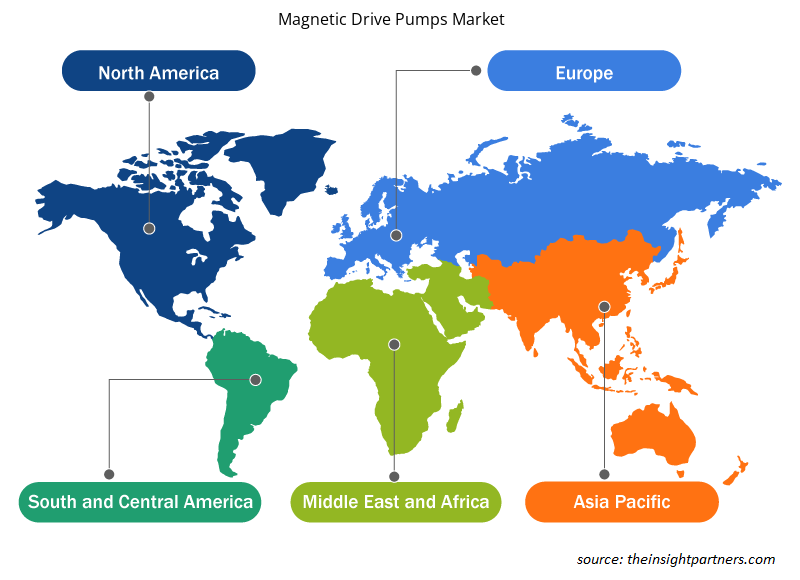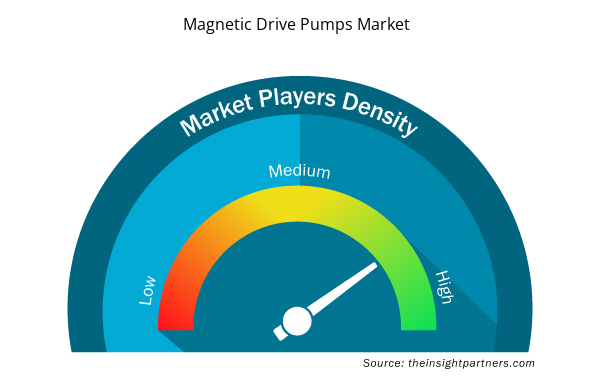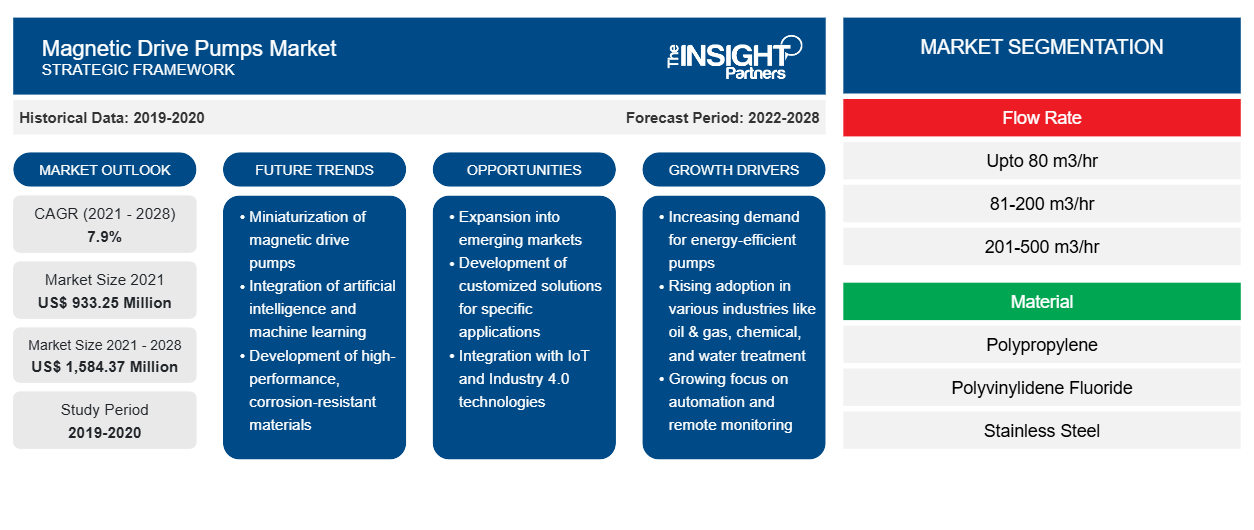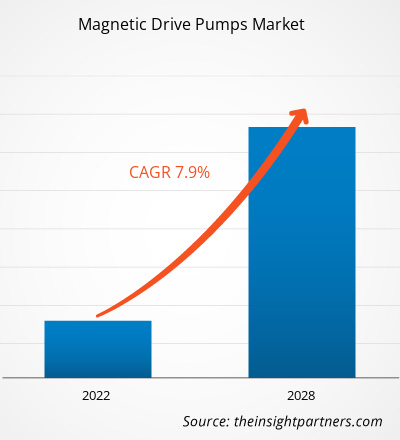[Rapporto di ricerca] Si prevede che il mercato delle pompe a trasmissione magnetica crescerà da 933,25 milioni di dollari nel 2021 a 1.584,37 milioni di dollari entro il 2028; si stima che crescerà a un CAGR del 7,9% nel periodo 2021-2028.CAGR of 7.9% during 2021–2028.
Prospettiva dell'analista:
Il mercato delle pompe a trasmissione magnetica è un settore in rapida crescita nell'industria globale delle pompe . Le pompe a trasmissione magnetica, note anche come pompe a trasmissione magnetica o pompe ad accoppiamento magnetico, sono progettate per eliminare la necessità delle tradizionali tenute meccaniche utilizzando un accoppiamento magnetico per trasferire la coppia dal motore alla girante. Questa tecnologia offre diversi vantaggi, tra cui funzionamento senza perdite, requisiti di manutenzione ridotti e maggiore sicurezza. Il mercato delle pompe a trasmissione magnetica ha assistito a una crescita significativa negli ultimi anni, guidata da vari fattori. Uno dei principali fattori trainanti è la crescente domanda di soluzioni di pompaggio senza guarnizioni in settori quali l'elaborazione chimica, i prodotti farmaceutici, il trattamento delle acque e il petrolio e il gas. La capacità delle pompe a trasmissione magnetica di eliminare le perdite e ridurre il rischio di esposizione a materiali pericolosi le rende altamente desiderabili in queste applicazioni. Inoltre, le severe normative ambientali e una crescente enfasi sull'efficienza operativa hanno alimentato l'adozione di pompe a trasmissione magnetica. L'eliminazione delle perdite non solo riduce la perdita di prodotto, ma riduce anche al minimo l'impatto sull'ambiente. Inoltre, le pompe a trasmissione magnetica offrono una migliore efficienza energetica rispetto alle pompe tradizionali, contribuendo al risparmio sui costi e alla sostenibilità.
Il mercato delle pompe a trascinamento magnetico è caratterizzato da vari tipi di pompe a trascinamento magnetico, tra cui pompe centrifughe, a turbina e a ingranaggi, ciascuna adatta per applicazioni e requisiti specifici. Le pompe centrifughe a trascinamento magnetico sono il tipo più comunemente utilizzato, offrendo portate elevate e capacità di pressione moderate. Le pompe a trascinamento magnetico a turbina sono adatte per applicazioni a bassa portata e alta pressione, mentre le pompe a trascinamento magnetico a ingranaggi sono ideali per la gestione di fluidi viscosi.
Panoramica del mercato:
Le pompe a trasmissione magnetica spostano il fluido attraverso una pompa impiegando un magnete di trasmissione e un magnete interno collegato a una girante. Il magnete di trasmissione e il magnete interno sono separati da un involucro posteriore e da un alloggiamento, con conseguente confinamento senza tenuta. L'utilizzo di una pompa a trasmissione magnetica può prevenire perdite di fluido e, cosa ancora più importante, la perdita di sostanze potenzialmente pericolose e costose. Le pompe senza guarnizioni non hanno emissioni fuggitive, il che consente loro di rispettare tutte le normative. Con una maggiore consapevolezza ambientale e normative EPA più severe, le pompe senza guarnizioni possono rispettare tutti i requisiti perché non producono emissioni fuggitive.
Personalizza questo report in base alle tue esigenze
Riceverai la personalizzazione gratuita di qualsiasi report, comprese parti di questo report, o analisi a livello nazionale, pacchetto dati Excel, oltre a usufruire di grandi offerte e sconti per start-up e università
- Scopri le principali tendenze di mercato in questo rapporto.Questo campione GRATUITO includerà analisi di dati che spaziano dalle tendenze di mercato alle stime e alle previsioni.
Fattore trainante del mercato:
Aumento dell'uso del trattamento delle acque per progetti di trattamento delle acque per guidare la crescita del mercato delle pompe a trasmissione magnetica
L'aumento dell'uso del trattamento delle acque per i progetti di trattamento delle acque è un fattore determinante per il mercato delle pompe a trasmissione magnetica. Il trattamento delle acque svolge un ruolo cruciale nella purificazione e nella garanzia della disponibilità di acqua pulita per varie applicazioni, tra cui acqua potabile, processi industriali e irrigazione agricola. Con l'aumento della domanda di acqua pulita, la necessità di soluzioni efficaci ed efficienti per il trattamento delle acque diventa sempre più critica. Le pompe a trasmissione magnetica trovano ampia applicazione nei processi di trattamento delle acque grazie al loro design senza guarnizioni e alla capacità di gestire fluidi corrosivi e pericolosi. Queste pompe sono adatte per la gestione di sostanze chimiche, acidi e altre sostanze aggressive comunemente utilizzate nelle operazioni di trattamento delle acque. L'assenza di guarnizioni meccaniche elimina il rischio di perdite e contaminazione, garantendo l'integrità dell'acqua trattata. I progetti di trattamento delle acque comprendono varie applicazioni, tra cui impianti di trattamento delle acque comunali, impianti di trattamento delle acque reflue industriali, impianti di desalinizzazione e progetti di bonifica delle falde acquifere. In queste applicazioni, le pompe a trasmissione magnetica sono fondamentali per il pompaggio e la circolazione dell'acqua attraverso varie fasi di trattamento, come filtrazione, disinfezione, dosaggio chimico e gestione dei fanghi.
La crescente enfasi sulle normative ambientali e sugli standard di qualità dell'acqua spinge ulteriormente l'adozione di pompe a trasmissione magnetica nei progetti di trattamento delle acque. Le severe normative richiedono sistemi di pompaggio affidabili e senza perdite per impedire il rilascio di inquinanti nei corpi idrici. Le pompe a trasmissione magnetica forniscono una soluzione affidabile eliminando il potenziale di perdite e garantendo la protezione dell'ambiente. Inoltre, l'efficienza e i vantaggi operativi delle pompe a trasmissione magnetica le rendono una scelta interessante per i progetti di trattamento delle acque. Queste pompe presentano un'elevata efficienza energetica, che aiuta a ridurre i costi operativi e a minimizzare l'impatto ambientale. Inoltre, l'assenza di tenute meccaniche si traduce in minori requisiti di manutenzione, risparmiando tempo e risorse per gli operatori del trattamento delle acque.
Analisi segmentale: Analysis:
In base al materiale, il mercato è suddiviso in polipropilene, fluoruro di polivinilidene, acciaio inossidabile, leghe di nichel, PFA ed ETFE. Il segmento dell'acciaio inossidabile ha detenuto la quota maggiore del mercato delle pompe a trasmissione magnetica nel 2020, mentre si prevede che il segmento delle leghe di nichel registrerà il CAGR più elevato nel mercato durante il periodo di previsione. Il segmento dell'elaborazione chimica detiene la quota maggiore del mercato delle pompe a trasmissione magnetica. Le pompe a trasmissione magnetica sono ampiamente utilizzate nell'elaborazione chimica perché gestiscono fluidi corrosivi e prevengono le perdite. L'attenzione del settore alla sicurezza, alle normative ambientali e all'efficienza operativa spinge l'adozione di pompe a trasmissione magnetica. Queste pompe offrono un funzionamento senza perdite, garantendo l'integrità dei materiali pericolosi e riducendo la perdita di prodotto. Forniscono inoltre efficienza energetica, minori requisiti di manutenzione e supportano l'ottimizzazione dei processi. Con l'espansione dell'industria chimica, le pompe a trasmissione magnetica rimarranno fondamentali per soddisfare le sue esigenze di pompaggio.
Analisi regionale:
Il mercato delle pompe a trasmissione magnetica dell'Asia Pacifico è stato valutato a 0,31 miliardi di $ USA nel 2021 e si prevede che raggiungerà 0,58 miliardi di $ USA entro il 2028; si prevede che crescerà a un CAGR del 9,3% durante il periodo di previsione. La regione dell'Asia Pacifico è emersa come il mercato dominante delle pompe a trasmissione magnetica, esibendo una crescita sostanziale e una quota di settore significativa. Il predominio della regione può essere attribuito a diversi fattori chiave che hanno contribuito alla sua leadership di mercato. La regione dell'Asia Pacifico ha sperimentato una rapida industrializzazione e crescita economica negli ultimi decenni. Ciò ha aumentato la domanda di vari processi industriali, tra cui la produzione chimica, la produzione farmaceutica, il trattamento delle acque e altro ancora. La necessità di soluzioni di pompaggio affidabili ed efficienti in questi settori ha portato a un'adozione significativa delle pompe a trasmissione magnetica. La grande popolazione della regione e la crescente urbanizzazione hanno spinto la domanda di infrastrutture migliorate, tra cui impianti di trattamento delle acque e delle acque reflue . Le pompe a trasmissione magnetica svolgono un ruolo fondamentale in questi progetti, garantendo una gestione efficiente e sicura dei fluidi in diverse applicazioni. L'attenzione della regione allo sviluppo sostenibile e al rispetto delle normative ambientali ha ulteriormente stimolato l'adozione di pompe a trascinamento magnetico nei processi di trattamento delle acque.
La regione Asia-Pacifico ha numerosi hub di produzione, in particolare in paesi come Cina, India e Corea del Sud. Questi paesi hanno una solida presenza in settori quali prodotti chimici, petrolchimici ed elettronici, che sono i principali consumatori di pompe a trasmissione magnetica. Le capacità di produzione locale e i vantaggi in termini di costi di questi paesi hanno alimentato la crescita del mercato. I progressi nella tecnologia e i crescenti investimenti in ricerca e sviluppo hanno svolto un ruolo cruciale nel dominio del mercato della regione. I produttori nella regione Asia-Pacifico sono stati in prima linea nello sviluppo di soluzioni innovative per pompe a trasmissione magnetica che soddisfano specifiche esigenze del settore. Ciò ha ulteriormente rafforzato la loro competitività e ha contribuito alla forte posizione di mercato della regione.
Analisi dei giocatori chiave:
L'analisi di mercato delle pompe a trascinamento magnetico è composta da attori quali IWAKI CO., LTD.; Sundyne; Klaus Union GmbH & Co. KG; Flowserve Corporation; Dickow Pump Company; KSB SE & Co. KGaA; ITT Goulds Pumps; Sulzer Ltd; Finish Thompson, Inc.; OPTIMEX; HERMETIC-Pumpen GmbH; CP Pumpen AG; e CDR Pumps. Tra gli attori delle pompe a trascinamento magnetico Sulzer Ltd e Klaus Union GmbH & Co. KG sono tra i principali attori grazie al portafoglio di prodotti diversificato offerto.
Approfondimenti regionali sul mercato delle pompe a trasmissione magnetica
Le tendenze regionali e i fattori che influenzano il mercato delle pompe a trasmissione magnetica durante il periodo di previsione sono stati ampiamente spiegati dagli analisti di Insight Partners. Questa sezione discute anche i segmenti e la geografia del mercato delle pompe a trasmissione magnetica in Nord America, Europa, Asia Pacifico, Medio Oriente e Africa e Sud e Centro America.

- Ottieni i dati specifici regionali per il mercato delle pompe a trasmissione magnetica
Ambito del rapporto di mercato sulle pompe a trasmissione magnetica
| Attributo del report | Dettagli |
|---|---|
| Dimensioni del mercato nel 2021 | 933,25 milioni di dollari USA |
| Dimensioni del mercato entro il 2028 | 1.584,37 milioni di dollari USA |
| CAGR globale (2021 - 2028) | 7,9% |
| Dati storici | 2019-2020 |
| Periodo di previsione | 2022-2028 |
| Segmenti coperti | Per portata
|
| Regioni e Paesi coperti | America del Nord
|
| Leader di mercato e profili aziendali chiave |
|
Densità dei player del mercato delle pompe a trasmissione magnetica: comprendere il suo impatto sulle dinamiche aziendali
Il mercato delle pompe a trasmissione magnetica sta crescendo rapidamente, spinto dalla crescente domanda degli utenti finali dovuta a fattori quali l'evoluzione delle preferenze dei consumatori, i progressi tecnologici e una maggiore consapevolezza dei vantaggi del prodotto. Con l'aumento della domanda, le aziende stanno ampliando le loro offerte, innovando per soddisfare le esigenze dei consumatori e capitalizzando sulle tendenze emergenti, il che alimenta ulteriormente la crescita del mercato.
La densità degli operatori di mercato si riferisce alla distribuzione di aziende o società che operano in un particolare mercato o settore. Indica quanti concorrenti (operatori di mercato) sono presenti in un dato spazio di mercato in relazione alle sue dimensioni o al valore di mercato totale.
Le principali aziende che operano nel mercato delle pompe a trasmissione magnetica sono:
- Società per azioni Flowserve
- Sulzer Ltd
- KSB SE & Co. KGaA
- Soleggiato
- Unione di Klaus
Disclaimer : le aziende elencate sopra non sono classificate secondo un ordine particolare.

- Ottieni una panoramica dei principali attori del mercato delle pompe a trasmissione magnetica
Sviluppi recenti:
Le strategie inorganiche e organiche come fusioni e acquisizioni sono ampiamente adottate dalle aziende nel mercato delle pompe a trasmissione magnetica. Di seguito sono elencati alcuni recenti sviluppi chiave del mercato:
- Nel gennaio 2021, Flowserve Corporation, fornitore leader a livello mondiale di prodotti e servizi per il controllo dei flussi, ha lanciato una suite di servizi IoT per consentire il monitoraggio remoto degli impianti di produzione, comprese pompe di ogni tipo, prevedere guasti alle apparecchiature ed evitare interruzioni aziendali.
- Analisi storica (2 anni), anno base, previsione (7 anni) con CAGR
- Analisi PEST e SWOT
- Valore/volume delle dimensioni del mercato - Globale, regionale, nazionale
- Industria e panorama competitivo
- Set di dati Excel



Report Coverage
Revenue forecast, Company Analysis, Industry landscape, Growth factors, and Trends

Segment Covered
This text is related
to segments covered.

Regional Scope
North America, Europe, Asia Pacific, Middle East & Africa, South & Central America

Country Scope
This text is related
to country scope.
Domande frequenti
The use of magnetic drive pumps has increased in the renewable energy sector for the last few years. Biodiesel is a kind of liquid fuel produced from renewable sources like new and used vegetable oils and animal fats. Biodiesel is a much cleaner-burning replacement for various petroleum-based fuels. This is the reason for the growing demand for petroleum in various parts of the world. Magnetic drive pumps are designed and manufactured for optimum application in biodiesel production. These pumps are highly recommended for chemical transfer and chemical recirculation.
On the basis of material, the magnetic drive pumps market is segmented into polypropylene, polyvinylidene fluoride, stainless steel, nickel alloys, PFA, and ETFE. The stainless steel segment has the largest market share because the stainless steel pumps are mostly used due to its wide range of benefits including reduced initial cost of the pump, coupled with low operational cost with better quality. And major key players prefer stainless steel as casing material for magnetic drive pumps, including Magnatex Pumps, Inc.; Sichuan Zigong Pump & Valve Co., Ltd.; and March Manufacturing, Inc. Further, the nickel alloys segment has the faster growth rate due to growing adoption of magnetic drive pumps in chemical industry, petrochemical industry, refrigeration & heat transfer, oil & gas, power, and on/offshore plants.
Magnetic drive pumps are generally costlier compared to mechanical seal pumps. However, the maintenance costs are very low during the pump's service life, and such kind of long-term financial advantages are considered by end users while choosing the pump. The primary reason for lesser maintenance is the relatively simple design. Generally, when utilized for normal operations, it is normally seen that the magnetic drive pumps function for ten years or longer before requiring any kind of repair. Even when needed, the repairs are quite inexpensive. Magnetic drive pumps are manufactured to be driven by the force of magnets. Owing to this, the magnetic drive pumps do not have any shaft coming out of the pump casing, and there is no requirement for shaft sealing devices such as mechanical seals and gland packing.
On the basis of application, the magnetic drive pumps market is segmented into chemical processing, water treatment, surface treatment, food processing, oil and gas, and renewable energies. The chemical processing segment has the largest market share because the chemical pumps are widely required by several industries for transferring hazardous/dangerous fluids, ultra-pure liquids, and hard-to-seal liquids. Further, the water treatment segment has the faster growth rate due to the rising water treatment projects such as wastewater treatment in emerging economies such as North America, Europe, and Asia Pacific regions. The need of wastewater treatment is due to the growing population, urbanization, improving manufacturing activity, and rising oil & gas production.
In APAC, the magnetic drive pumps market is growing due to the increasing large-scale industrialization and urbanization. Countries such as China, South Korea, and Thailand have discovered new oil & gas reserves. Further, China and India have a greater number of chemical industries. Hence, the consumption of magnetic drive pumps is increasing with the growth of industries in the region. Another reason behind strong growth of magnetic drive pumps market over the years is the presence of large number of market players in the regions. Some of the key players in the APAC magnetic drive pumps market include; Kirloskar Brothers Limited (India), TEIKOKU ELECTRIC MFG. CO., LTD. (Japan), NIKKISO EIKO Co., Ltd. (Japan), and Zhejiang Yonjou Technology Co., Ltd (China), among others.
The environmental and safety impact of the respective fluid handling solutions is considered a top agenda while buying, using, and maintaining new pumps. Magnetic drive pumps are still firmly adopted for corrosive chemical applications. These pumps are characterized by enhanced corrosion resistance and dry running capabilities in the most severe conditions. Green technology is creating considerable demand for magnetic drive pumps in the methods of biodiesel fuels production, where mixtures of solvents and caustics create difficulties in sealing. Magnetic drive pumps help prevent fugitive emissions like volatile hazardous air pollutants (VHAPs) and volatile organic compounds (VOCs). Thus, using a magnetic drive pump helps the companies to stay compliant with the new state, local, and federal safety and health standards and regulations and avoid expensive fines.
Trends and growth analysis reports related to Manufacturing and Construction : READ MORE..
The List of Companies - Magnetic Drive Pumps Market
- Flowserve Corporation
- Sulzer Ltd
- KSB SE & Co. KGaA
- Sundyne
- Klaus Union
- Dickow Pump Company
- ITT Goulds Pumps
- Finish Thompson Inc.
- CDR Pumps
- OPTIMEX
- HERMETIC-Pumpen GmbH
- CP Pumpen AG
- IWAKI CO., LTD.
The Insight Partners performs research in 4 major stages: Data Collection & Secondary Research, Primary Research, Data Analysis and Data Triangulation & Final Review.
- Data Collection and Secondary Research:
As a market research and consulting firm operating from a decade, we have published and advised several client across the globe. First step for any study will start with an assessment of currently available data and insights from existing reports. Further, historical and current market information is collected from Investor Presentations, Annual Reports, SEC Filings, etc., and other information related to company’s performance and market positioning are gathered from Paid Databases (Factiva, Hoovers, and Reuters) and various other publications available in public domain.
Several associations trade associates, technical forums, institutes, societies and organization are accessed to gain technical as well as market related insights through their publications such as research papers, blogs and press releases related to the studies are referred to get cues about the market. Further, white papers, journals, magazines, and other news articles published in last 3 years are scrutinized and analyzed to understand the current market trends.
- Primary Research:
The primarily interview analysis comprise of data obtained from industry participants interview and answers to survey questions gathered by in-house primary team.
For primary research, interviews are conducted with industry experts/CEOs/Marketing Managers/VPs/Subject Matter Experts from both demand and supply side to get a 360-degree view of the market. The primary team conducts several interviews based on the complexity of the markets to understand the various market trends and dynamics which makes research more credible and precise.
A typical research interview fulfils the following functions:
- Provides first-hand information on the market size, market trends, growth trends, competitive landscape, and outlook
- Validates and strengthens in-house secondary research findings
- Develops the analysis team’s expertise and market understanding
Primary research involves email interactions and telephone interviews for each market, category, segment, and sub-segment across geographies. The participants who typically take part in such a process include, but are not limited to:
- Industry participants: VPs, business development managers, market intelligence managers and national sales managers
- Outside experts: Valuation experts, research analysts and key opinion leaders specializing in the electronics and semiconductor industry.
Below is the breakup of our primary respondents by company, designation, and region:

Once we receive the confirmation from primary research sources or primary respondents, we finalize the base year market estimation and forecast the data as per the macroeconomic and microeconomic factors assessed during data collection.
- Data Analysis:
Once data is validated through both secondary as well as primary respondents, we finalize the market estimations by hypothesis formulation and factor analysis at regional and country level.
- Macro-Economic Factor Analysis:
We analyse macroeconomic indicators such the gross domestic product (GDP), increase in the demand for goods and services across industries, technological advancement, regional economic growth, governmental policies, the influence of COVID-19, PEST analysis, and other aspects. This analysis aids in setting benchmarks for various nations/regions and approximating market splits. Additionally, the general trend of the aforementioned components aid in determining the market's development possibilities.
- Country Level Data:
Various factors that are especially aligned to the country are taken into account to determine the market size for a certain area and country, including the presence of vendors, such as headquarters and offices, the country's GDP, demand patterns, and industry growth. To comprehend the market dynamics for the nation, a number of growth variables, inhibitors, application areas, and current market trends are researched. The aforementioned elements aid in determining the country's overall market's growth potential.
- Company Profile:
The “Table of Contents” is formulated by listing and analyzing more than 25 - 30 companies operating in the market ecosystem across geographies. However, we profile only 10 companies as a standard practice in our syndicate reports. These 10 companies comprise leading, emerging, and regional players. Nonetheless, our analysis is not restricted to the 10 listed companies, we also analyze other companies present in the market to develop a holistic view and understand the prevailing trends. The “Company Profiles” section in the report covers key facts, business description, products & services, financial information, SWOT analysis, and key developments. The financial information presented is extracted from the annual reports and official documents of the publicly listed companies. Upon collecting the information for the sections of respective companies, we verify them via various primary sources and then compile the data in respective company profiles. The company level information helps us in deriving the base number as well as in forecasting the market size.
- Developing Base Number:
Aggregation of sales statistics (2020-2022) and macro-economic factor, and other secondary and primary research insights are utilized to arrive at base number and related market shares for 2022. The data gaps are identified in this step and relevant market data is analyzed, collected from paid primary interviews or databases. On finalizing the base year market size, forecasts are developed on the basis of macro-economic, industry and market growth factors and company level analysis.
- Data Triangulation and Final Review:
The market findings and base year market size calculations are validated from supply as well as demand side. Demand side validations are based on macro-economic factor analysis and benchmarks for respective regions and countries. In case of supply side validations, revenues of major companies are estimated (in case not available) based on industry benchmark, approximate number of employees, product portfolio, and primary interviews revenues are gathered. Further revenue from target product/service segment is assessed to avoid overshooting of market statistics. In case of heavy deviations between supply and demand side values, all thes steps are repeated to achieve synchronization.
We follow an iterative model, wherein we share our research findings with Subject Matter Experts (SME’s) and Key Opinion Leaders (KOLs) until consensus view of the market is not formulated – this model negates any drastic deviation in the opinions of experts. Only validated and universally acceptable research findings are quoted in our reports.
We have important check points that we use to validate our research findings – which we call – data triangulation, where we validate the information, we generate from secondary sources with primary interviews and then we re-validate with our internal data bases and Subject matter experts. This comprehensive model enables us to deliver high quality, reliable data in shortest possible time.


 Ottieni un campione gratuito per questo repot
Ottieni un campione gratuito per questo repot